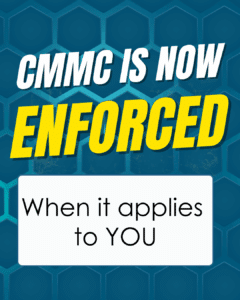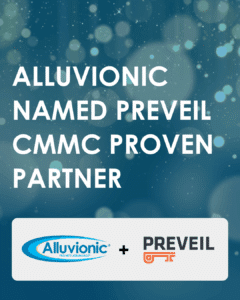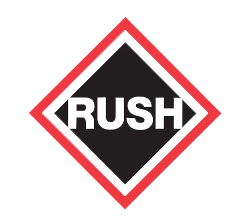
CMMC DFARS Rule Now in Effect: Do You Need to Certify?
What to Know About the November 10 Rule You may have heard that November 10, 2025 was a big day for cybersecurity compliance in the
CMMC is here! Register for our free webinar with guests from C3PAOs – Nov 18 @ 1PM EST. Save Your Spot →
Are You Ready With POA&Ms?

Unlike the previous all-or-nothing certification process, the new standards allow for time-limited POA&Ms. This adjustment enables businesses to address specific controls over an extended period, making it possible to allocate resources more effectively without compromising security.
Why Does the DoD Allow POA&Ms Now?
This marks a significant shift from the original CMMC 1.0 framework, which required all practices to be implemented before a company could be certified. That “all-or-nothing” approach proved to be too rigid—especially for small and mid-sized businesses.
By allowing some flexibility, CMMC 2.0 recognizes the real-world complexity of implementing security controls. The 180-day remediation window allows you to:
But again—this flexibility comes with a clock and strict rules.
What is a POA&M?
Plans of Actions and Milestones (POA&Ms) serve as corrective action plans for areas not fully compliant with specified controls. Now permissible under certain conditions, POA&Ms provide a pathway to full CMMC compliance without requiring a perfect initial assessment.
Every POA&M must be clear, trackable, and accountable. Here’s what each plan should include:

Every POA&M item will be re-evaluated during a POA&M validation, which can be conducted by either the Organization Seeking Assessment (OSA) or a third-party C3PAO depending on the type of assessment.
Let’s say your organization has not implemented proper audit log retention procedures (AU.L2-3.3.9). This is a one-point requirement under NIST SP 800-171 rev 2 and is eligible for POA&M.
Your POA&M might include:
In traditional cybersecurity frameworks, Plans of Action and Milestones (POA&Ms) are often seen as a project management tool for IT teams. But in the CMMC 2.0 world, POA&Ms are highly regulated, strategically limited, and deeply integrated into the Defense Department’s contracting process.
This isn’t just an internal checklist. Rather, it’s a compliance mechanism that is tracked, enforced, and verified by third-party assessors (C3PAOs) and the DoD.
There are limitations to when and which POA&Ms are allowed. No POA&Ms are allowed for the foundational 17 CMMC Level 1 Controls, which are essential for maintaining basic cybersecurity hygiene within the DoD supply chain. These controls must be fully implemented to achieve any level of CMMC certification. For CMMC level 2, while most controls with a point value of “1” can have a POA&M, there are still exceptions, including:
AC.L1-3.1.20 – External Connections
AC.L1-3.1.22 – Control Public Information
PE.L1-3.10.3 – Escort Visitors
PE.L1-3.10.4 – Physical Access Logs
PE.L1-3.10.5 – Manage Physical Access
For organizations aiming for CMMC level 2, these changes are particularly relevant. Under the new guidelines, conditional certifications can be granted if a business implements at least 80% of the critical NIST SP 800-171 rev2 controls. Moreover, to maintain this conditional status, all POA&Ms items must be resolved within 180 days, a manageable timeframe for most businesses.
It’s easy to assume you’ve got half a year, but many organizations underestimate how long procurement, implementation, testing, and documentation can take. The 180-day timer starts immediately after your conditional assessment, and you’ll need to show full implementation by the closeout.
Common delays that eat into that window:
This is why project management discipline provided by a Registered Practitioner Organization (RPO) like Alluvionic, is critical.

Once your organization has completed the remediation activities, you’ll need to verify them in a closeout assessment. If your initial assessment was:
No matter the type, the closeout must demonstrate:
If your POA&Ms are not closed out within the deadline, your CMMC status will expire, and you could be deemed non-compliant making your organization ineligible for new DoD contracts.
Why This Matters for Your Business
POA&M requirements for achieving CMMC 2.0 certification underscore the framework’s role as a more business-friendly approach, acknowledging the challenges organizations face in achieving complete CMMC compliance. By allowing certain deficiencies to be temporarily accepted and later corrected, the new CMMC 2.0 POA&Ms requirements help contractors progressively enhance their cybersecurity practices.
Navigating the complexities of CMMC compliance, including understanding the nuances of POA&Ms and preparing for CMMC level 2, is crucial for maintaining and expanding your government contracts. Expert guidance can make this process significantly smoother and more effective.
We Can Help You With CMMC Compliance
At Alluvionic, we offer comprehensive support services for Cybersecurity gap analysis, DFARS Compliance Assistance, and CMMC Certification readiness support. Partnering with us ensures that your business not only meets the new standards but also thrives under them. Our expertise will help you achieve and maintain compliance efficiently, positioning your company for continued success in the defense sector.
For expert assistance in achieving CMMC compliance and leveraging POA&Ms for your business’s growth, contact Alluvionic today.
With the CMMC Final Rule officially published, compliance is no longer optional. Soon, CMMC Level 1 or Level 2 certification will be a requirement for winning DoD contracts. Failing to meet these standards could mean losing valuable business opportunities.
Key CMMC Compliance Takeaways
Get CMMC-Ready with Alluvionic Today
CMMC compliance can be overwhelming, but you don’t have to do it alone. At Alluvionic, we cut through the complexity, eliminate uncertainty, and make compliance achievable for small and mid-sized government contractors.
Take Action Now
Don’t wait until the deadline—secure your contracts by ensuring CMMC compliance today.

What to Know About the November 10 Rule You may have heard that November 10, 2025 was a big day for cybersecurity compliance in the

ICYMI: Insights from Our Webinar — CMMC Contract Clause DFARS 252.204-7021 Explained The CMMC landscape shifted in a major way with the release of DFARS

Alluvionic Named PreVeil CMMC Proven Partner Alluvionic has been selected as a PreVeil CMMC Proven Partner, a designation awarded to partners who either received a







It’s simple. A project that gets off on the right foot is likely to take a successful journey. So why do so many projects fail? Use this checklist to assure your project succeeds from the beginning.

Whether you need project management, process improvement, cybersecurity, product development, training, or government services, Alluvionic has the expertise to provide Peace of Mind and Project Assurance®.